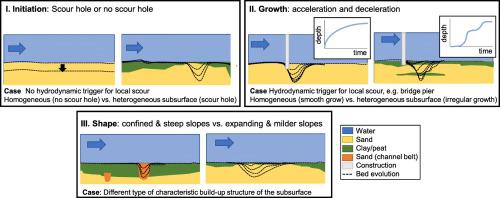Geomorphology ( IF 3.9 ) Pub Date : 2021-04-06 , DOI: 10.1016/j.geomorph.2021.107720 Ymkje Huismans , Hilde Koopmans , Ane Wiersma , Tjalling de Haas , Koen Berends , Kees Sloff , Esther Stouthamer

|
River deltas commonly have a heterogeneous substratum of alternating peat, clay and sand deposits. This has important consequences for the river bed development and in particular for scour hole formation. When the substratum consists of an erosion resistant top layer, erosion is retarded. Upon breaking through a resistant top layer and reaching an underlying layer with higher erodibilty, deep scour holes may form within a short amount of time. The unpredictability and fast development of these scour holes makes them difficult to manage, particularly where the stability of dikes and infrastructure is at stake.
In this paper we determine how subsurface lithology controls the bed elevation in net incising river branches, particularly focusing on scour hole initiation, growth rate, and direction. For this, the Rhine-Meuse Estuary forms an ideal study site, as over 100 scour holes have been identified in this area, and over 40 years of bed level data and thousands of core descriptions are available. It is shown that the subsurface lithology plays a crucial role in the emergence, shape, and evolution of scour holes. Although most scour holes follow the characteristic exponential development of fast initial growth and slower final growth, strong temporal variations are observed, with sudden growth rates of several meters per year in depth and tens of meters in extent. In addition, we relate the characteristic build-up of the subsurface lithology to specific geometric characteristics of scour holes, like large elongated expanding scour holes or confined scour holes with steep slopes. As river deltas commonly have a heterogeneous substratum and often face channel bed erosion, the observations likely apply to many delta rivers. These findings call for thorough knowledge of the subsurface lithology, as without it, scour hole development is hard to predict and can lead to sudden failures of nearby infrastructure and flood defence works.
中文翻译:

莱茵-默兹河口冲刷孔形成的岩性控制
河流三角洲通常具有泥炭,粘土和沙土交替沉积的异质基底。这对于河床的发展,特别是冲刷孔的形成具有重要的影响。当底层由抗腐蚀顶层组成时,腐蚀受到阻碍。在突破抗性顶层并到达具有较高可透性的底层时,可能会在短时间内形成深层冲刷孔。这些冲孔的不可预测性和快速发展使其难以管理,尤其是在堤防和基础设施的稳定性受到威胁的情况下。
在本文中,我们将确定地下岩性如何控制净切河分支中的河床标高,特别是侧重于冲刷孔的形成,生长速率和方向。为此,莱茵河-默兹河口是一个理想的研究地点,因为该区域已经发现了100个冲孔,并且已有40多年的床位数据和成千上万的岩心描述。结果表明,地下岩性在冲孔的出现,形状和演化中起着至关重要的作用。尽管大多数冲刷孔遵循快速初始生长和较慢最终生长的特征性指数发展,但观察到强烈的时间变化,深度每年突然增长几米,而范围则突然增长几十米。此外,我们将地下岩性的特征与冲孔的特定几何特征联系起来,例如大型细长的冲孔或陡峭的受限冲孔。由于河三角洲通常具有非均质的地层,并且经常面临河床冲蚀,因此这些观测结果很可能适用于许多三角洲河流。这些发现要求对地下岩性有透彻的了解,因为没有它,很难预测冲孔的发生,并可能导致附近基础设施和防洪工程的突然失效。


























 京公网安备 11010802027423号
京公网安备 11010802027423号